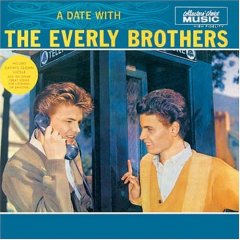
Tracks: Made to Love//That's Just Too Much//Stick With Me Baby//Baby What You Want Me To Do//Sigh, Cry, Almost Die//Always It's You//Love Hurts//Lucille//So How Come (No One Loves Me)//Donna, Donna//A Change of Heart//Cathy's Clown
The Everly brothers do have a lot of good ideas. They take the basic Buddy Holly country-rock template, graft on their impressive close-harmony singing, and then flesh things out with wide-ranging borrowing from other fields of pop and rock. Album-opener “Made to Love” boasts a surfy Link Ray beat and vocals that wouldn’t be out of place in a doo-wop song. “Cathy’s Clown”, the most interesting track in sonic terms, features a staggered marching-band beat over which the Everlys caterwaul melancholically in a style directly comparable with the early Beatles (who ripped-off this song). It has more in common with an old-fashioned pop song of the type one expects Doris Day to start belting out than the bluesy nonsense of Elvis and his like, complete with time changes and several clearly distinct sections.
Obviously, the levels of writing are considerably higher than usual, with a lot more chord changes and a more sophisticated approach to melody. And the arrangements are fascinating - guitars are layered and positively swirl, while “Always It’s You” boasts a glockenspiel and elaborate studio delay effects – gone is the irritating cheapness which has dogged all the rock albums on the list up to this point, and I for one thing that it’s about damned time. And hey, Roy Orbison ripped-off both “Love Hurts” (“You Got It”) and “Lucille” (“Pretty Woman”), so there’s that.
So, the Everlys have a lot of interesting ideas. Unfortunately they aren’t always being put in the service of memorable songs. “Made to Love” is a great catchy fist-pumper with empty-headed yet oddly endearing lyrics about women being programmed for love (Ah! To hear Dietrich cover this). “Donna, Donna” is similarly grand, yet less affirmative and more about how badly Donna screwed the Everlys over. And “Cathy’s Clown” is simultaneously the oddest song here and intensely enjoyable. All good there – the problem is, that’s only three songs on a twelve song album.
The other tracks aren’t worthless, they’re just not hit-you-in-the-face amazing. Lyrically, this is a very shallow affair – the Everly Brothers do an admirable job of capturing the Teenage Condition, but unfortunately the Teenage Condition is exceptionally tedious, relying as it does almost entirely on gut-reaction tear-jerking and pleas to the heart - a quick read of the track list tells you all you need to know. And look at the cover! Are you sad? Well, no fear - the Everly Borthers will date you even if no-one else will. If you can give yourself over to an entire album of self-absorbed whining then it’s a lot of fun, but you’re probably better off either ignoring the lyrics or listening to this just after the captain of the varsity football team gave Becky Winthrop his pin instead of you. And I mean ugh! She is such a slut! I mean, everyone knows she went down on Buck Jones in the back of his Plymouth after the Castle Beach Clam Bake. Oh god I am so fat... And if I don’t lose at least ten pounds then how am I ever going to marry Frankie Avalon?
Putting personal matters aside, this is a pretty good pop album. It has a few great moments, and is uniformly enjoyable – and how many albums can you point to where all the songs are good? Not many, really. And I may have complained of the simplicity of the lyrics, but on the other hand it does add a nice bit of immediacy to things. Plus, all the songs are short – about 2:20 on average – and both very slick and highly melodic. It may be sort of inconsequential, but then again pop music isn’t meant to be art. It’s meant to be a fun time or a simplistic augmentation of your current emotional state. And on that level, and as an interesting and important progresion in the development of rock, this more than delivers.
7.5/10




